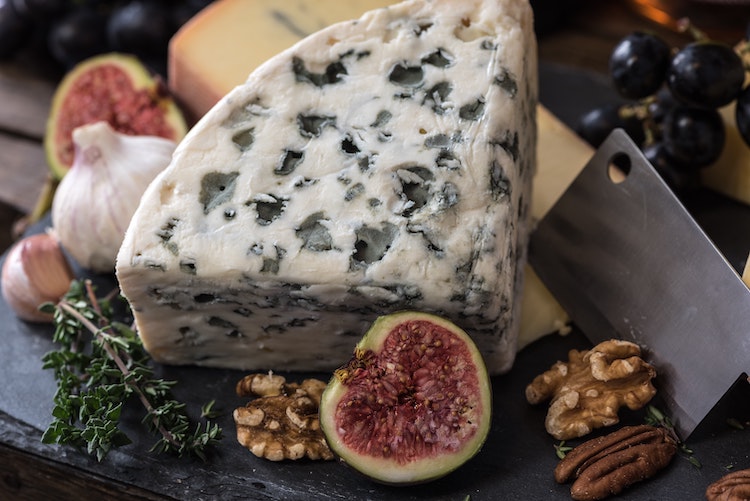In an earlier article, titled “Foods to Avoid When You Have Mold or Yeast in Your Body,” we discouraged our readers from eating foods that already contain mold or yeast, specifically dairy products, such as cheese. That said, we understand how difficult it is to give up cheese, even when your health weighs in the balance, so if you must indulge on occasion, I suggest you at least become better acquainted with the different types of cheese and which types pose the greater risk, such as the moldy cheese types that are deliberately infused with mold during crafting.
Moldy Cheese in General: Hard and Soft Cheeses
It’s important to take note of the distinction between hard and soft cheeses and how their differing structures relate to mold growth. It isn’t that one or the other develops mold at a faster rate or that either one presents more of a mold threat. It has more to do with how deep the mold can penetrate the cheese itself. So, for quick reference: soft cheeses have the deepest mold growth and hard cheeses have the most shallow mold growth. This means that if you have moldy cheese and are wondering if it’s safe to eat, the answer is as follows:
Soft Cheese: No. Throw it out.
Hard Cheese: Cut off the moldy bits.
We covered this in more detail in another article, so please feel free to make use of our search bar with the key phrase: “Soft or Hard: Which Moldy Cheese is Safe to Eat?”
Now, let’s dive right into the cheeses that the manufacturers deliberately infuse with strains of mold.
Mold-Infused Cheeses
I’m sure you’re aware that some cheesemakers intentionally craft moldy cheeses. Apparently, this infusion of mold enhances the flavor and provides benefits to the microbiome of the gut. While I’m not a fan, someone somewhere is probably salivating at the very idea of blue- or green-laced cheese that smells like armpits. But, while tastes may vary, the jury is definitely in regarding the gut flora claim.
To a healthy, well-balanced body, mold-infused cheese—eaten on occasion—could offer some beneficial microbes to the intestines. However, if you have Candida or mold sickness, you are not doing your gut a favor by eating mold-infused cheeses.
Having a yeast or mold illness is an indicator of an imbalanced internal microbiome, so introducing more mold will only wreak more havoc on your system.
Therefore, while I can’t stop you from eating cheese altogether, I can at least provide you with a list of moldy cheese types that you can watch out for. The problem may not arise in the grocery store, since you’re able to see the mold clearly through the packaging, but you might need this list for when you’re dining out and aren’t sure of the names mentioned throughout the menu, especially in regard to salads.
Moldy Cheese Types
When it comes to deliberately-moldy cheese, everything pretty much gets labeled as “blue cheese,” even if it’s laced with green or black tendrils of fungal tastiness.
Every cheese crafter has their own take on blue cheese. From mild and creamy to pungent and crumbly, blue cheese (or “bleu cheese”) is not only the most widely-known term for mold-infused cheese, it also seems to be among the top ten favorites of the United States’ cheeses with over 94.7 million pounds sold each year on the North American continent alone.
This blue-marbled beauty is crafted with pasteurized cow’s, sheep’s, or goat’s milk and ripened with cultures of the mold called penicillium. Penicillium is one of the most recognized genus of fungi because one of its species—Penicillium Chrysogenum—produces penicillin. Penicillin is a molecule that has saved many lives as an antibiotic. It is also employed in the production of a number of important biotechnology-produced enzymes and macromolecules (whatever that means, right?).
Penicillium mold species aren’t just used in moldy cheeses. They’re also used to improve the flavor of some types of hams and sausages (both of which are also not recommended on an antifungal diet—even without the mold infusion).
Important Note: While the penicilliN molecule is derived from a specific penicilliuM mold, please understand that the penicillium mold in your cheese is not the same as penicillin. It is a mold, not an antibiotic.
The History of Moldy Cheese
According to several sources, blue cheese originated first in both France and Italy, but there is evidence it simultaneously developed in Spain as well. Whichever source you prefer, the story always follows:
During the Middle Ages, a cheesemaker who kept his cheese in a temperature- and moisture-controlled cave, carelessly left behind a half-eaten loaf of bread one day. Upon his return some days later, he discovered that the mold that had developed on his bread had infiltrated the nearby cheeses and caused a marbling of blue all throughout.
Thus, whether it began in Roquefort, France or Gorgonzola, Italy or Cabrales, Spain, this is always the blue cheese backstory.
Types of Blue Cheese
Blue cheese goes by several names, depending on its point of origin and the type of livestock it is sourced from. There are many varieties of blue cheese. As stated above, early versions were produced in France and Italy, and later versions evolved throughout Europe and North America. Depending on the type, the texture and flavor can vary greatly. From crumbly, weepy, salty, and sharp to softer, creamy, and mildly earthy, blue cheese never seems to run out of variety. Some versions are enriched with cream, have a soft middle, and are wrapped in a bloomy (soft and fluffy) rind. Other versions can be slightly harder with a thick mottled rind (Stilton) or a clean salted rind protected by foil (Roquefort).
No matter the version and flavor profile of a blue cheese, however, you are always guaranteed a spectacular visual of green, blue, gray, or black veins or spots of mold marbled all throughout the body of the cheese.
While all that sounds rather tantalizing to some of you, try to remember that I’m telling you all this so you know what to watch out for as you do your best to stick to an antifungal diet. And with that, here is a list of the five most common types of blue cheese names to avoid on the menu:
1. Danish Blue
2. Gorgonzola
3. Cabrales
4. Stilton
5. Roquefort
While those are the blue cheeses you are most-likely to run into at restaurants, it might be helpful to leave you with a more exhaustive list of moldy cheese types so you don’t accidentally order a dish with moldy cheese under an unfamiliar name:
• Ädelost
• Aura cheese
• Beenleigh Blue
• Bleu Bénédictin
• Bleu d’Auvergne
• Bleu de Bresse
• Bleu de Gex
• Bleu des Causses
• Bleu du Vercors-Sassenage
• Bleuchâtel
• Blue Cheshire
• Brighton Blue
• Buxton Blue
• Cabrales cheese
• Cambozola
• Carré d’Aurillac
• Cashel Blue
• Castello
• Cherni Vit
• Danish Blue Cheese
• Dolcelatte
• Dorset Blue Vinney
• Dovedale cheese
• Dragon’s Breath Blue
• Fourme d’Ambert
• Fourme de Montbrison
• Gamalost
• Gorgonzola
• Grinzola
• Kariki Tinou
• Lanark Blue
• Lymeswold cheese
• Maytag Blue cheese
• Niva
• Norbury Blue
• Oxford Blue
• Perl Las
• Picón Bejes-Tresviso
• Remberter
• Rogue River Blue
• Rokpol
• Roquefort
• Saga
• Saint Agur Blue
• Shropshire Blue
• Stichelton
• Stilton cheese
• Valdeón cheese
• Wensleydale cheese
• Yorkshire Blue
Fun Fact: In 2019—for the first time ever!—a U.S.-made cheese was named “The Best Cheese in the World” by The World Cheese Awards held in Italy that year. That cheese was none other than Rogue River Blue—a blue cheese crafted in Central Point, Oregon by Rogue Creamery.
Conclusion
Although penicillium molds have brought about many benefits to man, they are also a major contributor to mold sickness problems because they invade buildings at an alarming rate. According to the Centers for Disease Control and Prevention (CDC), penicillium molds are among the top four common indoor molds that pose a serious health threat to humans and pets.
This is because penicillium fungi are common allergens, triggering reactions such as hypersensitivity pneumonitis and hay fever. They can also exacerbate asthma symptoms.
While penicillium is typically non-pathogenic, there are some exceptions. Several penicillium species are capable of producing microbial volatile organic compounds (MVOCs) and toxins that can be harmful, especially if there is long-term exposure.
That said, this doesn’t mean that the mold in your moldy cheese is the exact same mold growing in your floorboards, but it does drive home the overall point of this article. Even the edible molds have the potential to be dangerous, especially if you already have a mold-induced condition or a gut flora imbalance.
Therefore, while blue cheeses may be tasty, I highly recommend you avoid them until your fungal health issues are solved. Give your body time to recover fully and your gut to rebalance before reintroducing moldy cheese types back into your diet.
For more information regarding mold, mold prevention, and mold solutions, please check out the rest of MoldBlogger.com.


